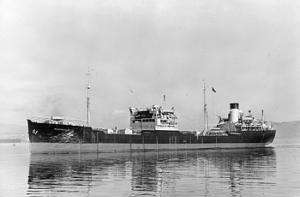RFA Broomdale (A168)
RFA Broomdale (A168) was a Dale-class fleet tanker of the Royal Fleet Auxiliary. She spent much of her career in the Indian Ocean and Far East.
 | |
| History | |
|---|---|
| Name: | RFA Broomdale |
| Ordered: | 1936 |
| Builder: | Harland and Wolff, Govan |
| Laid down: | January 1937 |
| Launched: | 2 September 1937 |
| Commissioned: | 3 November 1937 |
| Decommissioned: | 12 April 1959 |
| Fate: | Arrived at Bruges for scrapping on 2 January 1960 |
| General characteristics | |
| Class and type: | Dale-class fleet tanker |
| Displacement: | 17,388 tonnes full load |
| Length: | 483 ft 1 in (147.24 m) |
| Beam: | 61 ft 8 in (18.80 m) |
| Draught: | 27 ft 5 in (8.36 m) |
| Propulsion: | Burmeister & Wain 6-cylinder diesels with a single shaft. 490 nhp |
| Speed: | 11.5 knots (21.3 km/h) |
| Complement: | 44 |
Construction and design
The ship was ordered from the British Tanker Company of London from Harland and Wolff and was laid down on 29 December 1936 with Yard number 975. She was one of six tankers purchased during construction by the British Government to allow replacement of worn out ships of the Royal Fleet Auxiliary.[1][2] She was launched as Broomdale on 2 September 1937,[3] and was completed on 3 November 1957, entering service the same day.[1]
Broomdale was 481 feet 6 inches (146.76 m) long overall and 464 feet 3 inches (141.50 m) between perpendiculars, with a beam of 62 feet (19 m) and a draught of 21 feet (6.4 m). She was powered by Doxford diesel engines rated at 4,000 brake horsepower (3,000 kW), giving a speed of 11.5 knots (21.3 km/h; 13.2 mph).[3] Broomdale displaced 17,338 long tons (17,616 t), with a deadweight tonnage of 11,650 long tons (11,840 t).[3] The ship had a Gross register tonnage of 8334 tons and a Net register tonnage of 4967 tons.[4] The ship had a complement of 40.[3]
Service
While undergoing sea trials at Glasgow on 4 February 1938, Broomdale was involved in a collision with the New Zealand Shipping Company's cargo passenger ship SS Ruahine. Broomdale underwent repairs at Greenock.[1] She spent the first year of the war operating between bases in Scotland and Norway, on 16 May 1940 she was attacked by four dive bombers and suffered minor damage from two near misses.[1] Towards the end of 1940 she was moved to operations in the South Atlantic based at Port Stanley.
In April 1942 she was assigned to the British Eastern Fleet at Ceylon. She took part in Operation Stab and spent the next three years fuelling and escorting convoys across the Indian Ocean. On 14 April 1944 she sustained minor damage from the explosion of the ammunition ship Fort Stikine, and then in August was accidentally torpedoed by the submarine HMS Severn, rupturing two tanks and killing one.[1]
After a brief trip back to the UK and the end of hostilities she was sent to the Far East, visiting Shanghai, Tokyo, Yokohama and Hong Kong.
She was refitted in 1947 and continued service across the world until sold in November 1959 and broken up two months later.
References
- "RFA Broomdale". Historical RFA. Royal Fleet Auxiliary Historical Society. Retrieved 23 February 2019.
- "Broomdale". The Yard. Retrieved 23 February 2019.
- Blackman 1953, p. 77
- "Lloyd's Register of Shipping 1938–39: BRO–BRU: 71373: Broomdale" (PDF). Retrieved 23 February 2019 – via Southampton City Council.
- Blackman, Raymond V. B., ed. (1953). Jane's Fighting Ships 1953–54. New York: McGraw-Hill Book Company Inc.CS1 maint: ref=harv (link)